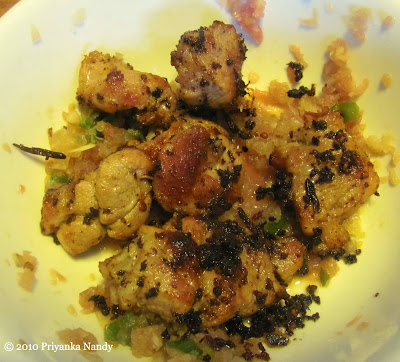

The second recipe is the coconut/milk recipe. Malaicurry served on special occasions is a more elaborate recipe, and consequently a more delicious dish, but for dinner at home, this works wonderfully well:
Ingred:
Diced potatoes, sliced green chilies, minced peeled ginger and chopped onions + two plum tomatoes.
Ground cumin, coriander and garam masala separately.
How to:
Heat ghee/mustard oil in a wok. Rub the potatoes with turmeric and salt and fry them till brown. Keep aside. Heat a little more ghee/oil. Add the ginger when the oil/ghee is hot. Add onions when you can smell the ginger frying. When the onions begin to change colour, add the green chilies and half the chopped tomatoes, disintergrating the latter in the wok or pan and mixing them well with the frying onions. Add the shrimps. Back home we briefly fry the shrimps before adding them to the curry. This gives them a delicious fried taste but also hardens them a little.

When the shrimps start taking on a red tinge, add the browned potatoes. Mix half a teaspoon of cumin and coriander powder with a little water to make a paste. Add this to the wok and fold in well. Cook on high for a minute or two, stirring and mixing all ingredients well.

Add half a cup of coconut milk, turn the flame to low, and let the milk seep into everything else. If you see signs of charring, a little water can be added to the milk to help keep things unburnt.

Add the rest of the tomatoes. Attack the tomatoes again till they no longer hold shape. Sprinkling a little salt on them will help.

After a minute or so, add two cups of water and give the whole pan a good swirl or two so the water mixes well with everything, making a watery gravy. Add salt and sugar to your tastes. Cover and simmer for ten or fifteen minutes (or till the potatoes are thoroughly cooked). If the gravy is still too watery, boil off without the cover. Turn off heat and add half a teaspoon of garam masala, and fold it in well. Serve with white rice.





































